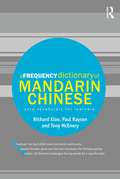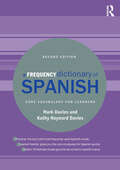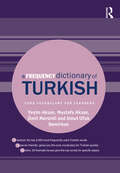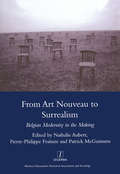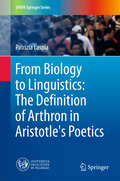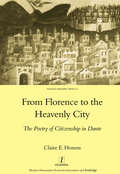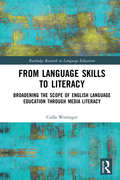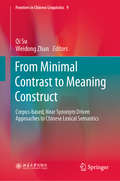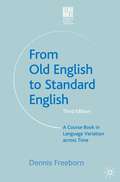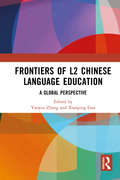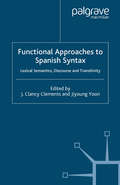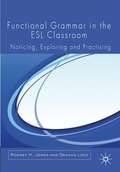- Table View
- List View
A Frequency Dictionary of Korean: Core Vocabulary for Learners (Routledge Frequency Dictionaries)
by Sun-Hee Lee Seok Bae Jang Sang Kyu SeoA Frequency Dictionary of Korean is an invaluable tool for all learners of Korean, providing a list of the 5000 most frequently used words in the language. Based on the Sejong National Corpora, the largest written and spoken corpora in Korean comprised of 10 million words collected from different genres, the Dictionary provides the user with detailed information for each of the entries, including illustrative examples and English translations. The Dictionary provides a rich resource for language teaching and curriculum design, while a separate CD version provides the full text in a tab-delimited format ideally suited for use by corpus and computational linguists. With entries arranged both by frequency and alphabetically, A Frequency Dictionary of Korean enables students of all levels to get the most out of their study of vocabulary in an engaging and efficient way.
A Frequency Dictionary of Korean: Core Vocabulary for Learners (Routledge Frequency Dictionaries)
by Sun-Hee Lee Seok Bae Jang Sang Kyu SeoA Frequency Dictionary of Korean is an invaluable tool for all learners of Korean, providing a list of the 5000 most frequently used words in the language. Based on the Sejong National Corpora, the largest written and spoken corpora in Korean comprised of 10 million words collected from different genres, the Dictionary provides the user with detailed information for each of the entries, including illustrative examples and English translations. The Dictionary provides a rich resource for language teaching and curriculum design, while a separate CD version provides the full text in a tab-delimited format ideally suited for use by corpus and computational linguists. With entries arranged both by frequency and alphabetically, A Frequency Dictionary of Korean enables students of all levels to get the most out of their study of vocabulary in an engaging and efficient way.
A Frequency Dictionary of Mandarin Chinese: Core Vocabulary for Learners (Routledge Frequency Dictionaries)
by Richard Xiao Paul Rayson Tony McEneryA Frequency Dictionary of Mandarin Chinese is an invaluable tool for all learners of Mandarin Chinese, providing a list of the 5,000 words and the 2,000 Chinese characters (simplified) most commonly used in the language. Based on a fifty-million-word corpus composed of spoken, fiction, non-fiction and news texts in current use, the dictionary provides the user with a detailed frequency-based list, as well as alphabetical and part-of-speech indexes. All entries in the frequency list feature the English equivalent and a sample sentence with English translation. The Dictionary also contains thirty thematically organized lists of frequently used words on a variety of topics such as food, weather, travel and time expressions. A Frequency Dictionary of Mandarin Chinese enables students of all levels to maximize their study of Mandarin vocabulary in an efficient and engaging way. It is also an excellent resource for teachers of the language. A CD version is available to purchase separately. Designed for use by corpus and computational linguists it provides the full text in a format that researchers can process and turn into suitable lists for their own research work.
A Frequency Dictionary of Mandarin Chinese: Core Vocabulary for Learners (Routledge Frequency Dictionaries)
by Richard Xiao Paul Rayson Tony McEneryA Frequency Dictionary of Mandarin Chinese is an invaluable tool for all learners of Mandarin Chinese, providing a list of the 5,000 words and the 2,000 Chinese characters (simplified) most commonly used in the language. Based on a fifty-million-word corpus composed of spoken, fiction, non-fiction and news texts in current use, the dictionary provides the user with a detailed frequency-based list, as well as alphabetical and part-of-speech indexes. All entries in the frequency list feature the English equivalent and a sample sentence with English translation. The Dictionary also contains thirty thematically organized lists of frequently used words on a variety of topics such as food, weather, travel and time expressions. A Frequency Dictionary of Mandarin Chinese enables students of all levels to maximize their study of Mandarin vocabulary in an efficient and engaging way. It is also an excellent resource for teachers of the language. A CD version is available to purchase separately. Designed for use by corpus and computational linguists it provides the full text in a format that researchers can process and turn into suitable lists for their own research work.
A Frequency Dictionary of Persian: Core vocabulary for learners (Routledge Frequency Dictionaries)
by Corey Miller Karineh Aghajanian-StewartA Frequency Dictionary of Persian is an invaluable tool for all learners of Persian, providing a list of the 5,000 most frequently used words in the language. Based on a 150 million word corpus of written and spoken Persian texts from the Iranian world, the Dictionary provides the user with a detailed frequency-based list, plus alphabetical and part-of-speech indices. All entries feature the English equivalent, and an example of use in context. The Dictionary also features thematically-based lists of frequently used words on a variety of topics. Also featured are some grammatically-oriented lists, such as simple verbs and light verb constructions, and comparisons of different ways of expressing the months of the year. The Dictionary provides a rich resource for language teaching and curriculum design, while a separate CD version provides the full text in a tab-delimited format ideally suited for use by corpus and computational linguists. A Frequency Dictionary of Persian enables students of all levels to build on their study of Persian in an efficient and engaging way.
A Frequency Dictionary of Persian: Core vocabulary for learners (Routledge Frequency Dictionaries)
by Corey Miller Karineh Aghajanian-StewartA Frequency Dictionary of Persian is an invaluable tool for all learners of Persian, providing a list of the 5,000 most frequently used words in the language. Based on a 150 million word corpus of written and spoken Persian texts from the Iranian world, the Dictionary provides the user with a detailed frequency-based list, plus alphabetical and part-of-speech indices. All entries feature the English equivalent, and an example of use in context. The Dictionary also features thematically-based lists of frequently used words on a variety of topics. Also featured are some grammatically-oriented lists, such as simple verbs and light verb constructions, and comparisons of different ways of expressing the months of the year. The Dictionary provides a rich resource for language teaching and curriculum design, while a separate CD version provides the full text in a tab-delimited format ideally suited for use by corpus and computational linguists. A Frequency Dictionary of Persian enables students of all levels to build on their study of Persian in an efficient and engaging way.
A Frequency Dictionary of Spanish: Core Vocabulary for Learners
by Mark Davies Kathy Hayward DaviesA Frequency Dictionary of Spanish has been fully revised and updated, including over 500 new entries, making it an invaluable resource for students of Spanish. Based on a new web-based corpus containing more than 2 billion words collected from 21 Spanish-speaking countries, the second edition of A Frequency Dictionary of Spanish provides the most expansive and up-to-date guidelines on Spanish vocabulary. Each entry is accompanied with an illustrative example and full English translation. The Dictionary provides a rich resource for language teaching and curriculum design, while a separate CD version provides the full text in a tab-delimited format ideally suited for use by corpus and computational linguistics. With entries arranged both by frequency and alphabetically, A Frequency Dictionary of Spanish enables students of all levels to get the most out of their study of vocabulary in an engaging and efficient way.
A Frequency Dictionary of Spanish: Core Vocabulary for Learners (Routledge Frequency Dictionaries Ser.)
by Mark Davies Kathy Hayward DaviesA Frequency Dictionary of Spanish has been fully revised and updated, including over 500 new entries, making it an invaluable resource for students of Spanish. Based on a new web-based corpus containing more than 2 billion words collected from 21 Spanish-speaking countries, the second edition of A Frequency Dictionary of Spanish provides the most expansive and up-to-date guidelines on Spanish vocabulary. Each entry is accompanied with an illustrative example and full English translation. The Dictionary provides a rich resource for language teaching and curriculum design, while a separate CD version provides the full text in a tab-delimited format ideally suited for use by corpus and computational linguistics. With entries arranged both by frequency and alphabetically, A Frequency Dictionary of Spanish enables students of all levels to get the most out of their study of vocabulary in an engaging and efficient way.
A Frequency Dictionary of Turkish (Routledge Frequency Dictionaries)
by Yeşim Aksan Mustafa Aksan Ümit Mersinli Umut Ufuk DemirhanA Frequency Dictionary of Turkish enables students of all levels to build on their study of Turkish in an efficient and engaging way. Based on a 50 million word corpus, A Frequency Dictionary of Turkish provides a list of core vocabulary for learners of Turkish as a second or foreign language. It gives the most updated, reliable frequency guidelines for common vocabulary in spoken and written Turkish. Each of the 5000 entries are supported by detailed information including the English equivalent, an illustrative example with English translation and usage statistics. The Dictionary provides a rich resource for language teaching and curriculum design, while a separate CD version provides the full text in a tab-delimited format ideally suited for use by corpus and computational linguists. With entries arranged by frequency, by suffixation and alphabetically, A Frequency Dictionary of Turkish enables students of all levels to get the most out of their study of vocabulary in an engaging and efficient way.
A Frequency Dictionary of Turkish: Core Vocabulary For Learners (Routledge Frequency Dictionaries)
by Yeşim Aksan Mustafa Aksan Ümit Mersinli Umut Ufuk DemirhanA Frequency Dictionary of Turkish enables students of all levels to build on their study of Turkish in an efficient and engaging way. Based on a 50 million word corpus, A Frequency Dictionary of Turkish provides a list of core vocabulary for learners of Turkish as a second or foreign language. It gives the most updated, reliable frequency guidelines for common vocabulary in spoken and written Turkish. Each of the 5000 entries are supported by detailed information including the English equivalent, an illustrative example with English translation and usage statistics. The Dictionary provides a rich resource for language teaching and curriculum design, while a separate CD version provides the full text in a tab-delimited format ideally suited for use by corpus and computational linguists. With entries arranged by frequency, by suffixation and alphabetically, A Frequency Dictionary of Turkish enables students of all levels to get the most out of their study of vocabulary in an engaging and efficient way.
From Art Nouveau to Surrealism: European Modernity in the Making
by Nathalie AubertThis volume of edited essays is the first one in English to offer a critical overview of the specific features of Belgian modernity from 1880 to 1940 in a multiplicity of disciplines: literature and poetry, politics, music, photography and drama. The first half of the book investigates the roots of twentieth century modernity in Belgian fin de siecle across a variety of genres (novel, poetry and drama), not only within but also beyond the boundaries of Symbolism. The contributors go on to examine the explosion of Belgian culture on the international scene with the rise of the avant-gardes, notably Surrealism: and the contribution made in minor genres, such as the popular novels of Simenon and Jean Ray, and the Tintin comics of Herge.
From Art Nouveau to Surrealism: European Modernity in the Making
by Nathalie AubertThis volume of edited essays is the first one in English to offer a critical overview of the specific features of Belgian modernity from 1880 to 1940 in a multiplicity of disciplines: literature and poetry, politics, music, photography and drama. The first half of the book investigates the roots of twentieth century modernity in Belgian fin de siecle across a variety of genres (novel, poetry and drama), not only within but also beyond the boundaries of Symbolism. The contributors go on to examine the explosion of Belgian culture on the international scene with the rise of the avant-gardes, notably Surrealism: and the contribution made in minor genres, such as the popular novels of Simenon and Jean Ray, and the Tintin comics of Herge.
From Biology to Linguistics: The Definition of Arthron in Aristotle's Poetics (UNIPA Springer Series)
by Patrizia LaspiaThis book attempts to solve Aristotle's definition of arthron in the XX chapter of the Poetics by seeing it in a new light. This definition has always been considered an unsolvable problem. Starting with a detailed analysis of the Greek text, and of the various attempts to emend the text in order to make sense of it, the book provides an analytical description of the critical literature, showing that the solutions proposed up to now need to be revised.The possible solution is found in viewing the XX chapter of the Poetics not as a classification of parts of speech, as it was usually supposed, but by considering the biological definitions of arthron in Aristotle's corpus. This leads to the conclusion that, in linguistics as well as in biology, arthron is a "joint". In this light, the book offers a new textual conjecture for the first example of arthron in the Poetics.
From Florence to the Heavenly City: The Poetry of Citizenship in Dante
by ClaireE. HonessDante's political thought has long constituted a major area of interest for Dante studies, yet the poet's political views have traditionally been considered a self-contained area of study and viewed in isolation from the poet's other concerns. Consequently, the symbolic and poetic values which Dante attaches to political structures have been largely ignored or marginalised by Dante criticism. This omission is addressed here by Claire Honess, whose study of Dante's poetry of citizenship focuses on more fundamental issues, such as the relationship between the individual and the community, the question of what it means to be a citizen, and above all the way in which notions of cities and citizenship enter the imagery and structure of the Commedia.
From Florence to the Heavenly City: The Poetry of Citizenship in Dante
by ClaireE. HonessDante's political thought has long constituted a major area of interest for Dante studies, yet the poet's political views have traditionally been considered a self-contained area of study and viewed in isolation from the poet's other concerns. Consequently, the symbolic and poetic values which Dante attaches to political structures have been largely ignored or marginalised by Dante criticism. This omission is addressed here by Claire Honess, whose study of Dante's poetry of citizenship focuses on more fundamental issues, such as the relationship between the individual and the community, the question of what it means to be a citizen, and above all the way in which notions of cities and citizenship enter the imagery and structure of the Commedia.
From Language Skills to Literacy: Broadening the Scope of English Language Education Through Media Literacy (Routledge Research in Language Education)
by Csilla WeningerThe narrowing of English language education curriculum in many contexts has negatively impacted classroom teaching and learning. High-stakes standardized testing, scripted curricula, and the commodification of English have converged to challenge socially meaningful classroom literacy instruction that promotes holistic development. Although in different ways, these factors have shaped the teaching of English as both first and second language. How can English educators respond? This book argues that the first step is to take account of the broader policy, political and cultural landscape and to identify the key constraints affecting teachers, students and parents. These will set the broad parameters for developing local pedagogic approaches, while still recognizing the constraints that actively push against them. Using Singapore English language teaching as a case study, this book illustrates how this process can unfold, and how media literacy principles were vernacularized to design English classroom pedagogies that stretched the bounds of what is acceptable and possible in the local context.
From Language Skills to Literacy: Broadening the Scope of English Language Education Through Media Literacy (Routledge Research in Language Education)
by Csilla WeningerThe narrowing of English language education curriculum in many contexts has negatively impacted classroom teaching and learning. High-stakes standardized testing, scripted curricula, and the commodification of English have converged to challenge socially meaningful classroom literacy instruction that promotes holistic development. Although in different ways, these factors have shaped the teaching of English as both first and second language. How can English educators respond? This book argues that the first step is to take account of the broader policy, political and cultural landscape and to identify the key constraints affecting teachers, students and parents. These will set the broad parameters for developing local pedagogic approaches, while still recognizing the constraints that actively push against them. Using Singapore English language teaching as a case study, this book illustrates how this process can unfold, and how media literacy principles were vernacularized to design English classroom pedagogies that stretched the bounds of what is acceptable and possible in the local context.
From Minimal Contrast to Meaning Construct: Corpus-based, Near Synonym Driven Approaches to Chinese Lexical Semantics (Frontiers in Chinese Linguistics #9)
by Qi Su Weidong ZhanThis book offers new perspectives on the study of Chinese lexical semantics, as well as discourse analysis and cognitive pragmatics based on lexical semantics. The first part focuses on fundamental issues in lexical semantic research, while the second features articles highlighting various aspects of the lexical category systems in Chinese. The third part discusses application-oriented research on lexical semantics. Presenting the latest research in the field, the book is a valuable resource for specialists in Chinese lexical semantics, as well as for researchers and students interested in grammar, theory of lexical semantics, and word/meaning processing.
From Old English To Standard English: A Course Book In Language Variation Across Time (PDF)
by Dennis FreebornThis practical course book explores the development of the language from Old English to the establishment of Standard English. This third edition has been expanded to provide further background information, with a supplementary website and new sections to outline the development of writing hands and provide a brief introduction to palaeography.
From Syntax to Discourse: Pronominal Clitics, Null Subjects and Infinitives in Child Language (Studies in Theoretical Psycholinguistics #29)
by C. Hamannclaim is that such morphological processes can be learnt without symbolization and innate knowledge. See Rumelhart and McClelland (1986) for the original model of past tense acquisition, Plunkett and Marchman (1993), Nakisa, Plunkett and Hahn (1996) and Elman et al. (1996) for developments and extensions to other morphological processes, and Marcus et al. (1992) and Pinker and Prince (1988) for criticism. One line of investigation supporting the view of language as a genetic endowment is closely linked to traditional research on language acquisition and argues as follows: If language is innate there must be phenomena that should be accessible from birth in one form or the other. Thus it is clear that the language of children, especially young children and preferably babies should be investigated. As babies unfortunately don't talk, the abilities that are available from birth must be established in ways different from the usual linguistic analysis. Psycholinguistic research of the last few years has shown that at the age of 4 and 8 months and even during their first week of life children already have important language skills. From the fourth day, infants distinguish their mother tongue from other languages. From the first months children prefer the sound of speech to 'other noise'. At the age of 4 months, infants prefer pauses at syntactic boundaries to random pauses.
Frontiers of L2 Chinese Language Education: A Global Perspective
by Yanyin ZhangOver the past four decades, learning Chinese as a second language has transformed from individual small-scale endeavors to organized mass studies worldwide. In a fast-changing world, the field of L2 Chinese language education is confronted by unprecedented challenges and opportunities. This book presents recent pedagogical practices, innovations and research in L2 Chinese language education across five continents. Bringing together a diverse range of leading researchers and educators, it showcases the latest knowledge, teaching-led research, innovative curriculum design and pedagogical practice in a variety of instructional contexts. Through a mix of overview chapters, empirical studies and critical discussions, the book addresses four key themes – formal instruction; language education technology; curriculum development; and critical overviews– and reflects the latest challenges and coping strategies for teaching and learning Chinese in an increasingly digital world. It will be essential reading for researchers, teachers and students of Chinese as a second language, as well as curriculum developers and textbook writers.
Frontiers of L2 Chinese Language Education: A Global Perspective
by Yanyin Zhang Xiaoping GaoOver the past four decades, learning Chinese as a second language has transformed from individual small-scale endeavors to organized mass studies worldwide. In a fast-changing world, the field of L2 Chinese language education is confronted by unprecedented challenges and opportunities. This book presents recent pedagogical practices, innovations and research in L2 Chinese language education across five continents. Bringing together a diverse range of leading researchers and educators, it showcases the latest knowledge, teaching-led research, innovative curriculum design and pedagogical practice in a variety of instructional contexts. Through a mix of overview chapters, empirical studies and critical discussions, the book addresses four key themes – formal instruction; language education technology; curriculum development; and critical overviews– and reflects the latest challenges and coping strategies for teaching and learning Chinese in an increasingly digital world. It will be essential reading for researchers, teachers and students of Chinese as a second language, as well as curriculum developers and textbook writers.
Function and Class in Linguistic Description: The Taxonomic Foundations of Grammar
by Mário Alberto PeriniThis book deals with the traditional problem of the classification of linguistic units, with a primary focus on word classes. The approach is descriptive rather than theoretical, and is based on the use of distinctive features analogous to the ones used in phonology, which entails a radical reworking of the traditional classification. The first part presents some basic notions such as the use of distinctive features and the role of word classes in grammar; classification by prototypes; and the use of world knowledge as a resource to assign thematic relations to constituents in the sentence. In the second part, some descriptive problems are examined, namely the classification of verbs according to valency; connectives, adverbs, and the internal constituents of the NP; and the classification of units larger than words. This book will be of use as a guide for linguists working on the description of natural languages, as well as a resource for students on courses in linguistic theory and description.
Functional Approaches to Spanish Syntax: Lexical Semantics, Discourse and Transitivity
by J. Clements J. YoonThe first usage-based approach of its kind, this volume contains twelve studies on key issues in Spanish syntax: word order, arguments, grammatical-relation marking, inalienable possession, ser and estar , adjective placement, small clauses and causatives. The studies are approached within a broad functionalist perspective. The studies strengthen the view that components of grammar intricately interact and that a usage-based approach to analyzing them offers new and insightful perspectives on some stubborn problems.
Functional Grammar in the ESL Classroom: Noticing, Exploring and Practicing (PDF)
by Graham Lock Rodney JonesA set of easy to use techniques helps students discover for themselves how grammar works in real world contexts and how grammatical choices are not just about form but about meaning. Sample teaching ideas, covering a wide range of grammatical topics including verb tense, voice, reference and the organization of texts, accompanies each procedure.

